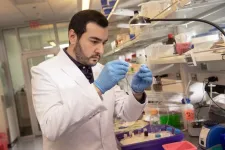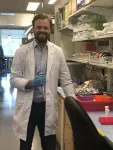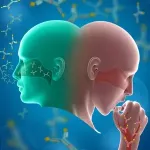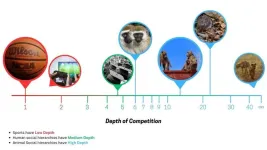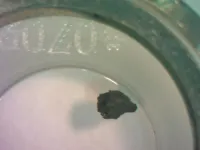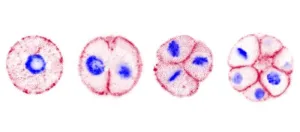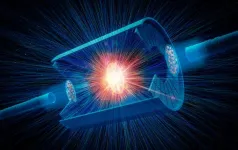(Press-News.org) A wide variety of COVID-19 symptoms exist, ranging from mild to severe, and while current strains of the virus generally cause milder symptoms, those with co-morbidities are still at an exponentially greater risk of severe disease. Now, new research from Emory University is providing a more precise prediction of COVID-19 severity that can be found by looking at autoantibodies in the nasal cavity, leading to more personalized treatment plans. For high-risk individuals, this could provide critical information to inform immediate treatment options, including quickly taking medications like Paxlovid within one week of symptoms to mitigate a severe response.
The study, published in Science Translational Medicine, followed 125 patients with varying levels of COVID-19 (from mild to severe) for nearly two years. They tracked antibodies in both the blood and nasal airways, finding that more than 70% of people with mild or moderate COVID-19 developed certain autoantibodies – generally an indication of disease – in the nose that were surprisingly linked to fewer symptoms, better antiviral immunity, and faster recovery.
The findings suggest that the presence of autoantibodies in the nose can play a protective role and help regulate the immune system to prevent excessive inflammation and fight off the virus more effectively.
“Generally, autoantibodies are associated with pathology and a negative prognosis, causing increased inflammation that would indicate more severe disease,” says Eliver Ghosn, senior author on the paper and faculty member of the Lowance Center for Human Immunology and Emory Vaccine Center. “What’s interesting about our findings is that with COVID-19, it’s the opposite. The nasal autoantibodies showed up soon after infection, targeting an important inflammatory molecule produced by the patient’s cells. These autoantibodies latched on to the molecule, likely to prevent excessive inflammation, and faded as people recovered, suggesting the body uses them to keep things in balance.”
Previous studies on COVID-19 patients have suggested that autoantibodies in the blood predispose them to life-threatening disease. However, these studies often neglect the nose - the actual site of infection. The new study suggests that the immune responses mounted in the nose against the virus differ from those in the blood. In short, nasal autoantibodies equal protection, whereas autoantibodies found in the blood equal severity.
“The key to this puzzle was to look directly at the site of infection, in the nose, instead of the blood,” says Ghosn. “While autoantibodies in the blood were linked to bad prognosis, producing them only in the nose soon after infection is linked to efficient recovery.”
FlowBEAT: A more efficient diagnostic tool
To allow more precise measurements of antibodies produced locally in the nasal site of infection, the Ghosn lab developed a new biotechnology tool called FlowBEAT to quantify different types of antibodies in nasal cavities and other biological samples, which could soon have implications for the testing of other respiratory viruses, like flu or RSV.
“Historically, the technology to measure antibodies has low sensitivity and is inefficient since they are limited to measuring one or a few antibodies at a time,” says Ghosn. “With FlowBEAT, we can take any standard nasal swab and perform a combination test to simultaneously measure all human antibody types against dozens of viral and host antigens in a single tube – a much more sensitive, efficient, and scalable way to measure for autoantibodies in the nose that can also predict the severity of symptoms.”
Next, the researchers want to find out whether this surprising mechanism to control COVID-19 infection in the nose also plays a role in other respiratory infections like flu and RSV.
“If this nasal autoantibody response turns out to be a common mechanism to protect us against other viral infections, it can be a paradigm shift in how we study protective immunity,” says Ghosn. “We will interpret autoantibodies through an innovative lens, hopefully inspiring new lines of research and better therapeutic options for common respiratory infections.”
Based on their findings, the Ghosn Lab is currently working with Emory’s patent office to develop a predictive diagnostic tool using “leftover” samples from standard nasal swabs widely used as a diagnostic test for COVID-19.
“Right now, we’re either looking at infection risk before it happens or analyzing the infection course well after recovery,” says Ben Babcock, a PhD candidate who led the study in the Ghosn Lab. “Imagine if we could capture the immune response in real-time, right in the clinic. A just-in-time test could give physicians and patients the real-time information they need to make faster, smarter treatment decisions.”
This study was part of a large collaboration between the Ghosn Lab at Emory and Drs. Sulggi Lee from UCSF and Nadia Roan from Gladstone Institutes, and in partnership with Emory laboratories of Drs. F. Eun-Hyung Lee, Iñaki Sanz, and Rabin Tirouvanziam.
CITATION: Babcock et al. Transient anti-interferon autoantibodies in the airways are associated with recovery from COVID-19. Science Translational Medicine, DOI.
FUNDING: This work was supported by the NIH’s National Institute of Allergy and Infectious Diseases (NIAID) awards R21AI167032, R01AI123126-05S1 and National Cancer Institute (NCI) award U54 CA260563 Emory SeroNet; COVID Fast Grant from Emergent Ventures at the Mercatus Center; and the Program for Breakthrough Biomedical Research Award. Ben Babcock was partially supported by the American Society of Hematology (ASH).
END
Nasal swab tests predict COVID-19 disease severity, Emory study finds
2024-11-06
ELSE PRESS RELEASES FROM THIS DATE:
'Shallow' sports and 'deep' social hierarchies: Not all pecking orders are created equal
2024-11-06
University of Michigan researchers have added a new dimension to the mathematics used to predict the outcomes of all manner of competitions, including sports, games and social hierarchies in both humans and animals.
This dimension, which they call "depth of competition," can be integrated into a variety of important and lucrative fields. It could, for instance, help project winners of match-ups in sports, forecast consumer preferences, rank universities and evaluate hiring practices.
But it also ...
New PFAs testing method created at UMass Amherst
2024-11-06
AMHERST, Mass. — University of Massachusetts Amherst researchers have discovered a new way to detect per- and polyfluoroalkyl substances (PFAS) in water. This marks an important step forward in creating testing devices that are simpler, more cost-effective, faster and generally more accessible than existing methods.
PFAS, the so-called forever chemicals, have been recognized as a concerning pollutant.
These chemicals persist in the environment because they resist breaking down and pose significant health threats. Exposure to these chemicals is linked to various cancers ...
Asteroid grains shed light on the outer solar system’s origins
2024-11-06
Tiny grains from a distant asteroid are revealing clues to the magnetic forces that shaped the far reaches of the solar system over 4.6 billion years ago.
Scientists at MIT and elsewhere have analyzed particles of the asteroid Ryugu, which were collected by the Japanese Aerospace Exploration Agency’s (JAXA) Hayabusa2 mission and brought back to Earth in 2020. Scientists believe Ryugu formed on the outskirts of the early solar system before migrating in toward the asteroid belt, eventually settling into an orbit between Earth and Mars.
The team analyzed Ryugu’s particles for signs of any ancient magnetic field that might have been present ...
Grant supports finding brain-inspired ways to develop low-energy computing
2024-11-06
The human brain is an astonishing organ, as any neuroscientist can attest. And its ability to collect, store, analyze and use information is intriguing to physicists, engineers and computer scientists, too.
Benjamin Jungfleisch, associate professor of physics at the University of Delaware, is among them.
Jungfleisch, who joined UD’s faculty in 2018, is an expert in magnon spintronics. He uses lasers to explore the dynamics of magnetic nanostructures — tiny magnets that can be used to ...
People engaging in self-harm find support on Reddit. But is that community helping them?
2024-11-06
A new study from the University of Georgia suggests people posting in Reddit’s r/selfharm community are likely seeking support for negative emotions.
While sharing traumatic events online can be cathartic, the researchers caution that subreddits can’t provide the same type of mental health help and support face-to-face interactions and professional help can.
“We don’t know the accuracy of the information that’s being shared in these communities about nonsuicidal self-injury,” ...
The egg or the chicken? An ancient unicellular says egg!
2024-11-06
Chromosphaera perkinsii is a single-celled species discovered in 2017 in marine sediments around Hawaii. The first signs of its presence on Earth have been dated at over a billion years, well before the appearance of the first animals. A team from the University of Geneva (UNIGE) has observed that this species forms multicellular structures that bear striking similarities to animal embryos. These observations suggest that the genetic programmes responsible for embryonic development were already present before the emergence of animal life, ...
Coping and resilience aids parents of disabled children, study says
2024-11-06
OXFORD, Miss. – For parents of children with disabilities, finding time to focus on themselves may be difficult. However, a new study finds that the right coping strategies and resilience can significantly help manage the challenges of raising children with special needs.
That is the key finding from research published in the International Journal of Developmental Disabilities that studied families with neurodevelopmentally disabled children in Ghana to see what helps parents cultivate healthy, happy lives for themselves and their children.
“Our main interest ...
Lupus Research Alliance announces inaugural recipients of Translational Bridge Award
2024-11-06
New York, NY. November 6, 2024. The Lupus Research Alliance (LRA) is excited to announce the first-ever recipients of the Translational Bridge Award (TBA), established this year to accelerate the translation of groundbreaking research into potential treatments and diagnostics for lupus. The award aims to propel high-potential projects from LRA-funded foundational discoveries with strong commercialization potential or an opportunity for clinical evaluation. Five exceptional researchers have been awarded the 2024 Translational Bridge Award to tackle pressing ...
Brain stars hold our memories
2024-11-06
A study published in Nature by researchers at Baylor College of Medicine changes the way we understand memory. Until now, memories have been explained by the activity of brain cells called neurons that respond to learning events and control memory recall. The Baylor team expanded this theory by showing that non-neuronal cell types in the brain called astrocytes – star-shaped cells – also store memories and work in concert with groups of neurons called engrams to regulate storage and retrieval of memories.
“The prevailing idea is that the formation and recall of memories only involves neuronal engrams that are activated by certain ...
Imaging nuclear shapes by smashing them to smithereens
2024-11-06
UPTON, N.Y. — Scientists have demonstrated a new way to use high-energy particle smashups at the Relativistic Heavy Ion Collider (RHIC) — a U.S. Department of Energy (DOE) Office of Science user facility for nuclear physics research at DOE’s Brookhaven National Laboratory — to reveal subtle details about the shapes of atomic nuclei. The method, described in a paper just published in Nature, is complementary to lower energy techniques for determining nuclear structure. It will add depth to scientists’ understanding of the nuclei that make up the ...
